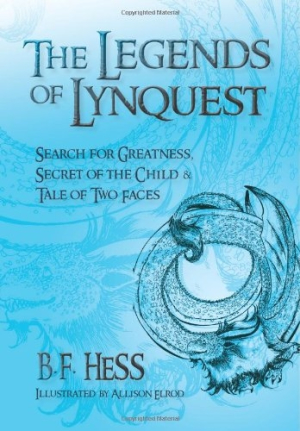The Legends of Lynquest
Search for Greatness & Secret of the Child & Tale of Two Faces
Hess writes with respect for his young audience in his broad, sweeping themes of cross-cultural unity and the power of individuals to change a course of action.
A mysterious and magical storyteller named Lynquest serves as both narrator and protagonist in this collection of three interrelated tales. Together the legends tell the story of a few brave individuals who endeavor to save a world endangered by evil. Narrated in a grand style reminiscent of classic folktales, the telling of this story spans generations and continents. Familiar fantasy elements like dragons, dark magic, mysterious strangers, and a princess in disguise lend appeal, and B. F. Hess’s formal but straightforward writing style makes this a great candidate for a family or classroom read-aloud.
The legends begin with a small boy named Tobias. Relentlessly bullied by other children, he finds comfort when Lynquest tells him of how he grew from the diminutive Tiny Lynquest to the respected Lynquest the Great. The tales end a generation later as Tobias’s daughter, Emily, undertakes her own quest to better herself and the world around her.
The individual journeys of Tobias, Lynquest, and Emily incorporate nearly every element of the fantasy genre a reader could imagine, from sea travel and palace intrigue to quests for lost objects and journeys through unfamiliar terrain. The characters’ stories wind back together for the climax when all three play a role in battling Salina, a sorceress who proudly proclaims herself “the source of human misery since the beginning of time.”
The human and animal characters are somewhat stock and one-dimensional. Tiny is as good as Salina is evil, and at times his words are too saccharine to be believable. For example, as he is essentially running away from home to avoid being bullied by his brothers, he says, “Though you have always treated me poorly, I want you to know, I have always cared for you and looked up to you both. I hope life treats you well.” However, illustrator Allison Elrod’s superb black-and-white illustrations, mainly portraits of dragons, cougars, snakes, and other fearsome creatures, truly bring the danger they embody to life in realistic detail.
While the characters and settings may be stock fantasy archetypes, the way in which the characters support each other in situations that have no perfect solution has a distinctly modern feel. Early in the book, a knight introduces the concept of “Bonangi,” which he says has “the power to bind all men together as one heart in wisdom, strength, compassion, and truth, or in confusion, ignorance, fear, and hatred. It is the spirit that moves all people in one direction or the other.” This sentiment guides the actions of all the main characters who endeavor to help each other make choices that will do the most good and the least harm.
Hess writes with respect for his young audience. His narrative style strikes a nice balance between a formal tone befitting such an epic tale and age-appropriate vocabulary and syntax, making this an easy read for young fans of the fantasy genre. Broad, sweeping themes of cross-cultural unity and the power of individuals to change a course of action recur throughout the tales. Each legend demonstrates the ways in which a person or partnership can affect the sway of Bonangi, and that no good deed is too small, a sentiment that will resonate with young readers.
Reviewed by
Carolyn Bailey
Disclosure: This article is not an endorsement, but a review. The publisher of this book provided free copies of the book and paid a small fee to have their book reviewed by a professional reviewer. Foreword Reviews and Clarion Reviews make no guarantee that the publisher will receive a positive review. Foreword Magazine, Inc. is disclosing this in accordance with the Federal Trade Commission’s 16 CFR, Part 255.

